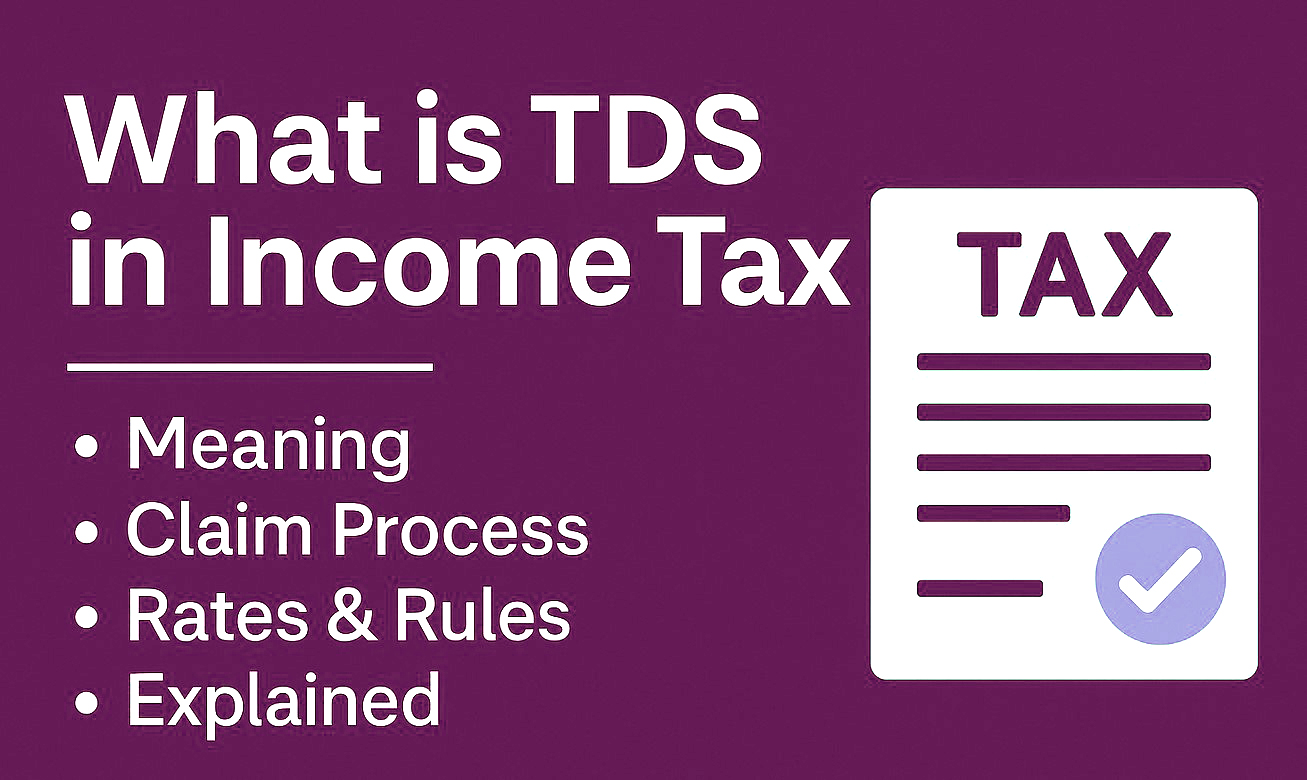Meta Description: Understand what is TDS in income tax, how it works, TDS claim process, latest rates, filing procedure, Form 26AS, refund eligibility, and more in a simple guide.
Table of Contents
- Introduction to TDS in Income Tax
- What is the Full Form and Meaning of TDS?
- Why is TDS Deducted?
- Who Deducts TDS and When?
- Key TDS Rates Applicable in India
- How to Check TDS Deducted (Form 26AS)
- How to Claim TDS While Filing ITR
- TDS Refund Process: Step-by-Step Guide
- Documents Required to Claim TDS
- Common Mistakes to Avoid
- Conclusion
- FAQs on TDS
Introduction to TDS in Income Tax
TDS or Tax Deducted at Source is a key feature in the Indian taxation system. The government collects tax at the source of income generation, which helps couple a tax from a steady revenue source and combat tax evasion. TDS is applicable to salaries, interest, rent, commission, and professional fees.
What is the Full Form & Meaning of TDS?
Tax Deducted at Source, or TDS, or TDS is an arrangement whereby the payer (the deductor) withheld tax before making payment to the payee (the deductee). Thus, the deductor deducts tax at the time of the transaction. The deducted tax is then deposited with the Income Tax Department.
Example: If your bank pays you ₹10,000 as interest, and your bank deducts ₹1,000 by way of TDS, you will receive ₹9,000, and ₹1,000 will go to the tax department.
Why is TDS Deducted?
The Income Tax Department uses TDS to:
- Ensure timely collection of taxes.
- Minimize tax evasion.
- Reduce the burden of lump sum payments at year-end.
- Bring transparency in income reporting.
Who Deducts TDS and When?
TDS is deducted by:
- Employers on salaries
- Banks on fixed deposit interest
- Companies on contractor payments
- Tenants (if rent exceeds ₹50,000 per month)
TDS must be deducted at prescribed rates, and deposited before the 7th of the next month.
Key TDS Rates Applicable in India
| Payment Type | TDS Rate | Threshold Limit |
| Salary | Slab-based | As per income tax slabs |
| Interest on FD | 10% | ₹40,000 (₹50,000 for senior citizens) |
| Rent (Land/Building) | 10% | ₹2.4 lakh per annum |
| Commission/ Brokerage | 5% | ₹15,000 per annum |
| Professional Fees | 10% | ₹30,000 per annum |
| Dividend from Companies | 10% | ₹5,000 |
Note: TDS rates are higher (20%) if PAN is not provided.
How to Check TDS Deducted (Form 26AS)
Form 26AS is a consolidated tax statement issued by the Income Tax Department.
How to view Form 26AS:
- Visit incometax.gov.in
- Login using PAN credentials
- Go to “e-File” > “Income Tax Returns” > “View Form 26AS”
- Select year & download the PDF/TXT file
How to Claim TDS While Filing ITR
When you file your Income Tax Return (ITR), the TDS amount is adjusted against your total tax liability. If excess TDS was deducted, you can claim a refund.
Steps to claim TDS:
- Login to incometax.gov.in
- Choose correct ITR form (e.g., ITR-1, ITR-2)
- Enter income details and TDS as per Form 26AS
- System auto-calculates your tax/refund
TDS Refund Process: Step-by-Step Guide
If your total tax liability is less than the TDS deducted, the balance is refunded to your account.
Steps for claiming a TDS refund:
- File ITR before due date
- Ensure PAN & bank details are correct
- TDS should match Form 26AS
- Submit ITR and e-verify it
- Refund is processed by CPC Bangalore (within 7-45 days)
Documents Required to Claim TDS
You may need:
- PAN card
- Aadhaar card
- Salary slips / Form 16
- Bank FD interest certificates
- Rent receipts (if applicable)
- Form 16A (for other TDS deductions)
Common Mistakes to Avoid
Mismatch of TDS with Form 26AS
Not filing ITR if TDS is deducted
Incorrect bank details – leads to refund failure
Forgetting to e-verify ITR
Ignoring TDS on small interest payments
Always cross-verify with Form 26AS and update PAN with all institutions.
Conclusion
TDS is a straightforward tax collection system that is also powerful. It ensures timely tax collection and transparency. For taxpayers like you, it is critical to know how TDS is deducted and file claims correctly to avoid penalties and timelines for claiming refunds. Always file your ITR timely and constantly track the status of your Form 26AS.
FAQs on TDS in Income Tax
Q1. What is the full form of TDS?
TDS stands for Tax Deducted at Source.
Q2. How do I know if TDS is deducted?
You can check your Form 26AS on the income tax portal.
Q3. What is the TDS rate for salary?
TDS is deducted on salary based on the slab of income tax to which you fall in.
Q4. Will I get any refund if excess TDS is deducted?
A Finance Ministry Directive, states that excess TDS deducted above your final tax liability will be refunded after you file your ITR.
Q5. What happens if I don’t file ITR after TDS is deducted?
You may lose your refunds and may face penalties too.
Q6. Is TDS for senior citizens different?
Yes, it is different like FD interest does include an exemption of ₹50,000 rather than ₹40,000.
Q7. When will I receive my TDS refunds?
You would generally receive your TDS refunds within 30 to 45 days of filing your ITR successfully and verification done electronically.
SEO Google Keywords : TDS in income tax, what is TDS, TDS full form in income tax, TDS claim process, TDS refund, how to claim TDS, TDS rates India, Form 26AS, income tax TDS, TDS deduction process, how TDS works, who deducts TDS, TDS refund online, TDS filing rules, TDS return process, TDS applicability
![]()

